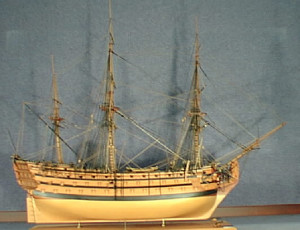The Ship
Royal George was built by J. Pawnell at Woolwich, a borough of London, England. The keel was laid January 1746 and she was launched February 1, 1756. A first-rate man of war, she carried 108 guns, including cannon and carronades, and at the time was considered the most beautiful ship afloat; the perfection of naval architecture. Being a fast ship, she carried more Admiral’s flags than any other ship up to the time of her loss in 1782.
In 1759, at Quiberon Bay, province of Brittany, France, Admiral Sir Edward Hawke took her into battle off Belle Isle, and blockaded the French fleet at Brest, stopping the plan to invade England. In the battle, the French lost seven ships of the line, including Le Superbe and Soleil Royal, and over 2,500 men were killed or drowned, putting an end to the invasion and at the same time destroying the French fleet—all while the weather was at its worst, with high winds and seas.
In 1782, Royal George, under Rear Admiral R. Kempenfelt, returned to Spithead to undergo repairs, but all that was found wrong was that a pipe that drew in water for washing the decks was leaking and needed replacing. In keeling her to one side to get to the pipe, the guns on the larboard side on both the decks were run out of the ports as far as they would go and the starboard guns were drawn into the midship line and secured, leaving the lower open ports just clear of the waterline. Water started to come in and the 1,200 people aboard, ( sailors and their families), were piped to larboard instead of to starboard, turning her on her side with her mast flat on the water. She sank, taking 1,000 with her, including Admiral Kempenfelt.
The Model
Scale: 3/16” H 43 ¾” L 51” W 22 12”
Built from the Admiralty plans from the National Maritime Museum at Greenwich, England, these were copies of the original ship in 1/8” scale converted to 3/16” scale by proportional dividers. The only alteration that was made to the plans was that Marple increased the original 18 station lines to 36 frames in order to obtain a smooth appearance to the planking. This gave the ship the frame-plus-frame as the original shipbuilders automatically would do.
Below the waterline is white holly. The waterline is cherry and the wales are ebony. The decks are boxwood laid side by side with black photographic paper between, creating the tarred effect of the ship’s deck.
The 500-hour figurehead is a two-headed horse with a centurion on each stirrup. In the center of the two heads, at the bottom, is King George’s shield. Above is a lion’s head topped by King George’s crown. Over each centurion is a cherub holding crowns at the heels of the horse. On each side are the sea serpents trying to get the centurions. This is one piece of boxwood, carved completely by hand, and the centurion swords are metal shaped by hand.
The stern gallery has many carvings, and all balustrades are made individually.
The upper deck is lined with sand buckets. The gratings are handmade.
The small life boats are double planked and fitted with oars and stern rudders.
The project lasted five years.

